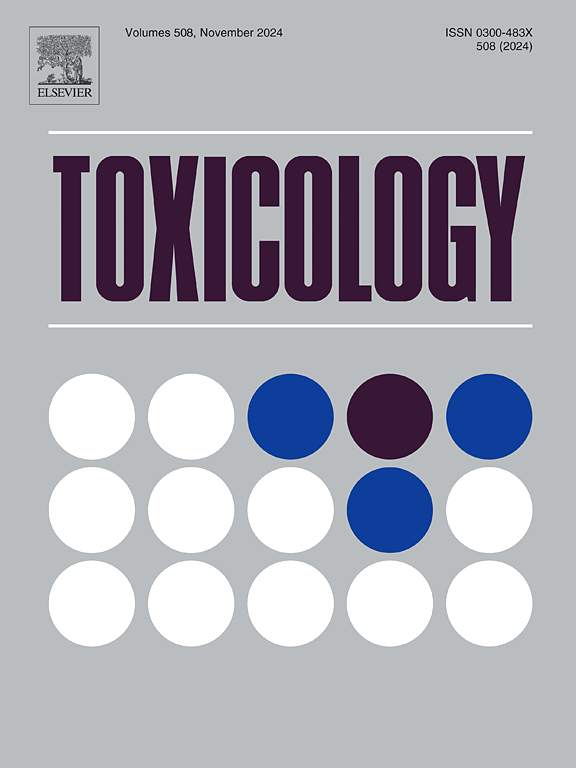肠道微生物组通过PI3K/Akt信号通路参与6ppd -醌诱导的认知障碍。
IF 4.6
3区 医学
Q1 PHARMACOLOGY & PHARMACY
引用次数: 0
摘要
研究表明,N-(1,3-二甲基丁基)-N'-苯基-对苯二胺醌(6PPD-Q)在中枢神经系统中蓄积,但其在认知障碍中的作用及其潜在机制尚不清楚。Morris水迷宫实验显示,6-PPDQ显著损害认知功能,尤其是学习和记忆功能。HE染色显示暴露小鼠海马DG和CA3区发生改变,包括细胞排列稀疏、边界模糊、核凝聚和尼氏体减少。6- ppdq暴露小鼠的粪便微生物群移植给正常小鼠可引起认知缺陷和海马病理损伤。Western Blot检测显示,6-PPDQ暴露导致PI3K/AKT信号通路的抑制。此外,在移植了6- ppdq相关小鼠粪便微生物群的小鼠中,观察到PI3K/AKT信号通路减弱。进一步的16S rDNA分析共鉴定出30种属水平的差异细菌,其中包括8种上调细菌,如g_Helicobacter和22种下调细菌,如g_Prevotellaceae_NK3B31_group。综上所述,本研究揭示了肠道微生物组通过抑制PI3K/Akt信号通路介导6ppd - q诱导的认知功能障碍,为进一步研究肠道微生物组对6- ppdq诱导的神经系统损伤的保护作用提供了基础。本文章由计算机程序翻译,如有差异,请以英文原文为准。
Gut microbiome contributes to 6PPD-quinone induced cognitive impairment through PI3K/Akt signaling
Studies show that N-(1,3-dimethylbutyl)-N′-phenyl-p-phenylenediamine-quinone (6PPD-Q) accumulates in the central nervous system, but its role in cognitive impairment and underlying mechanisms remain unclear. Morris water maze assay revealed that 6-PPDQ significantly impairs cognitive function, particularly learning and memory. HE staining revealed alterations in the hippocampal DG and CA3 regions of exposed mice, including sparse cell arrangement, blurred boundaries, nuclear condensation, and a reduction in Nissl bodies. Fecal microbiota transplantation from 6-PPDQ-exposed mice to normal mice induced cognitive deficits and hippocampal pathological damage. Western Blot assay showed that 6-PPDQ exposure resulted in inhibition of PI3K/AKT signaling. Moreover, blunted PI3K/AKT signaling was observed in mice transplanted with 6-PPDQ-associated mice fecal microbiota. Further analysis of 16S rDNA assay identified a total of 30 differential bacteria at the genus level, including 8 upregulated bacteria such as g_Helicobacter and 22 downregulated bacteria such as g_Prevotellaceae_NK3B31_group. In conclusion, this study uncovers gut microbiome mediates 6PPD-Q-induced cognitive impairment through inhibiting of PI3K/Akt signaling, and provides a basis for further investigation into gut microbiome's protective effects on 6-PPDQ-induced nervous system injury.
求助全文
通过发布文献求助,成功后即可免费获取论文全文。
去求助
来源期刊

Toxicology
医学-毒理学
CiteScore
7.80
自引率
4.40%
发文量
222
审稿时长
23 days
期刊介绍:
Toxicology is an international, peer-reviewed journal that publishes only the highest quality original scientific research and critical reviews describing hypothesis-based investigations into mechanisms of toxicity associated with exposures to xenobiotic chemicals, particularly as it relates to human health. In this respect "mechanisms" is defined on both the macro (e.g. physiological, biological, kinetic, species, sex, etc.) and molecular (genomic, transcriptomic, metabolic, etc.) scale. Emphasis is placed on findings that identify novel hazards and that can be extrapolated to exposures and mechanisms that are relevant to estimating human risk. Toxicology also publishes brief communications, personal commentaries and opinion articles, as well as concise expert reviews on contemporary topics. All research and review articles published in Toxicology are subject to rigorous peer review. Authors are asked to contact the Editor-in-Chief prior to submitting review articles or commentaries for consideration for publication in Toxicology.
 求助内容:
求助内容: 应助结果提醒方式:
应助结果提醒方式:


